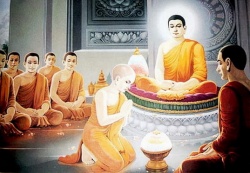Buddha visits the land of Nagas
The Buddha visited Sri Lanka on three occasions: first to Mahiyangana in January, second to Nagadipa in April, and third to Kelaniya in May, Vesak.
On the second visit made to Nagadipa, King Maniakkikha invited the Blessed One for a third visit to Kelaniya. And the Blessed One visited Kelaniya three years after his second visit, with 550 Arahants.
However Nishantha Gunawardena, a Sri Lankan historian living in US, mentions an interesting find in his 'The Lost Dynasty'; Buddha was not invited by King Maniakkhika but by a king namedPanitha and his daughter princess Abhi Upaliya. Nishantha cites rock inscriptions at Balaharukanda andBambaragastalawa that corroborate this find.
"...the rock inscriptions are more accurate due to the difficulty in changing or forging them. It was the national King Panitha who invited Gautama Buddha the second time. The regional King Maniakkhika is mentioned in a few other records.
But it was not until the December 2004 tsunami hit, the King reintroduced himself. As the tsunami tore through the island it exposed several rock inscriptions. Two of them bore the name King Maniagiya and his mother's name. This is, in fact, King Maniakkhika." (82pp)
King Maniakhikha is commonly mistaken as a Naga (snake) king, but scholars believe the king belonged to a clan named Naga. Following the Buddha's sermon in Kelaniya, the king erected a shrine with the Buddha's hair, utensils and the seat buried inside. However the foreign invasions have resulted in damaging the original shrine.
Kelaniya
The Kelaniya Raja Maha Vihara became more sacred following the Ven. Mahinda's arrival in Lanka to establish the Dhamma wheel officially. Mahavamsa, the official chronicle on Sri Lankan history written in the 5th century CE, states King Devanampiyatissa's brother Uttiya renovated the Dagoba along with the first quarters of the Monks, Shrine.
Mahavamsa interestingly relates how the Blessed One headed to Adam's Peak or Sumanakuta from Kelani on the Vesak Poya day. The 7359-ft-tall conical mountain has a historic significance as Buddhists believe it has the Buddha's footprint on it.
The mount is normally known as Adam's Peak for Christians and Shivan Adipatham (Shiva's footprint) for Hindus. The mount obviously has become the meeting place for people of diverse religions and ethnicities.
In Sinhala the mount is known as Sri Pada, a term derived from Sanskrit denoting the Sacred Foot. The Sinhala Samanala Kanda, or Butterfly Mountain in English, is named thus because of the butterflies annually migrating to the region.
Legend has it that the Buddha placed his left footprint on the hill summit and then strode across to Thailand, then Siam. In Siam the Buddha is said to have left the impression of the right foot; this is called Phra Sat, similar to Sri Pada. In his Bharhut Stupa General Sir A. Cunningham has details about footprints: "Footprints of the Buddha were most probably an object of reverence from a very early period - certainly before the building of the Bharut Stupa - as they are represented in two separate sculptures there. In the sculpture the footprints are placed on a throne or altar, canopied by an umbrella hung with garlands.
A royal personage is kneeling before the altar, and reverently touching the footprints with his hands. The second example is in the bas-relief representing the visit of Ajata-satru to Buddha. Here, as in all other Bharut sculptures, the Buddha does not appear in person, his presence being marked by His two footprints.
The wheel symbol is duly marked on both' (112pp). A cave temple called Diva Guhava is recognised as the place the Buddha had a rest during his Sripada Visit along with his retinue. The cave is said to have the capacity to provide shelter for over 500 people.
Siripa samaya, the season of Sripa pilgrimage starts in December and ends in May. "When the Teacher, compassionate to the whole world," goes on Mahavamsa, account of the great clan, "had preached the doctrine there, he rose, the Master, and left the traces of his footsteps plain to sight on Sumanakuta.
And after he had spent the day as it pleased him at the foot of this mountain, with the brotherhood, be set forth for Dighavapi."
Some historians however see the Buddha's visit to Dighavapi far from being likely. As the chronicle states, the Buddha had Himself visited the village and meditated consecrating the place. A shrine was later erected on the place the Blessed One meditated.
Many works including Samantha Pasadika and Dipavamsa contain allusions to Dighavapi.
The works mention the inhabitants of Dighavapi were Yakkas, with links to pre-Aryan Kirat people in Northern India. As a legend goes, while a novice monk was repairing a part of the shrine, he fell from the top. He heard the shouting of his
colleagues to recall Dhajagga Paritta, a Sutta reciting the great qualities of the Buddha, Dhamma and Sangha. And finally, it is said, the novice monk was saved miraculously. The area was later reconstructed by King Saddhatissa.
Some sources indicate that the Buddha set foot on Kataragama following the visit to Dighavapi. Legend has it that the Buddha met King Mahasena (some sources identify the king as Mahaghosha) in Kataragama.
The King listened to the Buddha and erected a shrine - now known as Mangala Ceitya - on the place he preached. The place is now called Kiri Vehera, located close to the Hindu temple built by the same King.
According to a source discovered by Nishantha Gunawardena the Mangala Ceitya contains the sword that Prince Siddhartha used to cut his hair in renouncing. However, as Nishantha adds, the source is yet to be verified.

